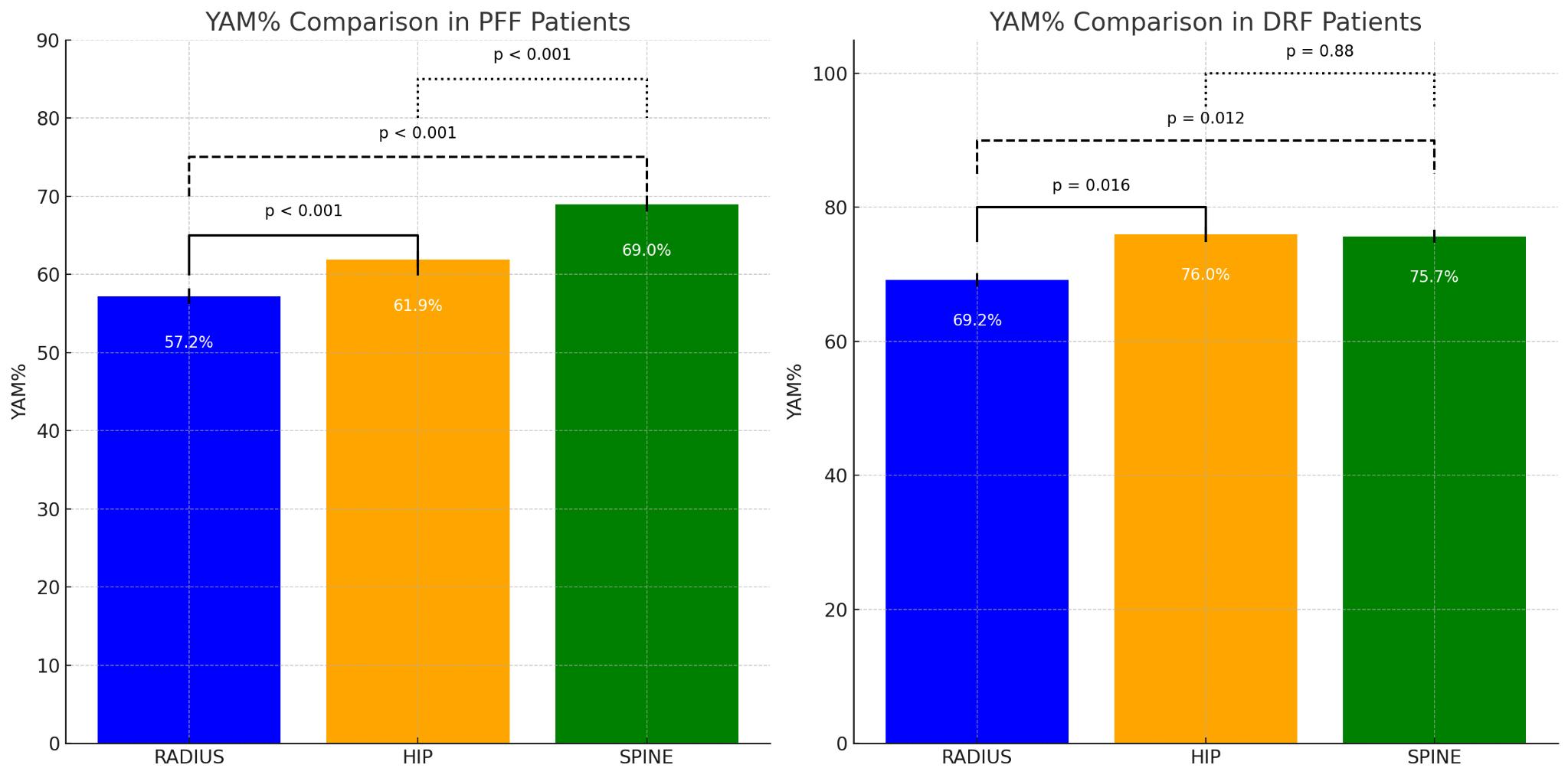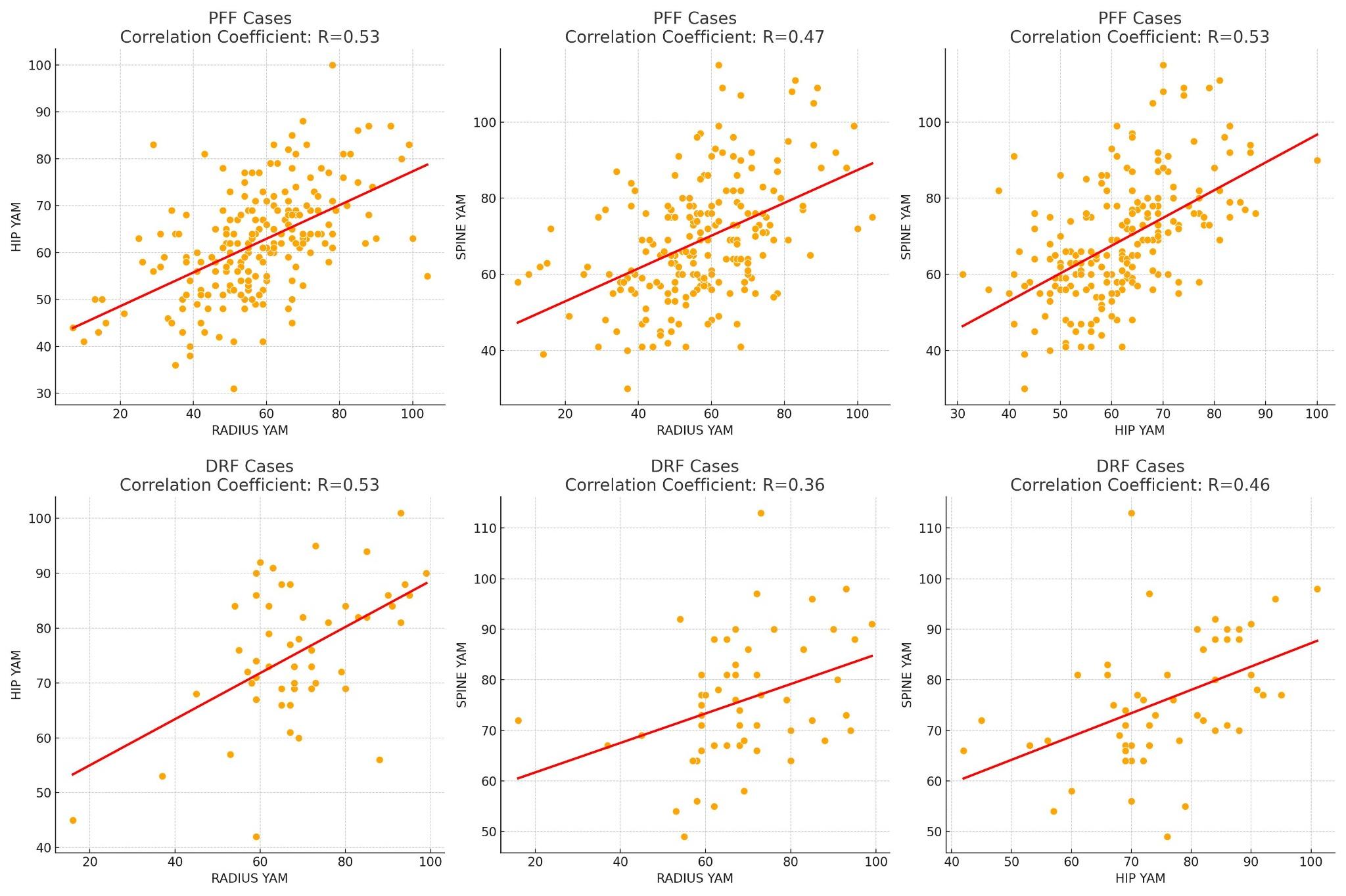Session Information
Date: Monday, November 18, 2024
Title: Osteoporosis & Metabolic Bone Disease – Basic & Clinical Science Poster
Session Type: Poster Session C
Session Time: 10:30AM-12:30PM
Background/Purpose: Osteoporosis is often diagnosed based on bone mineral density (BMD) measurements at the hip or lumbar spine. However, our previous study reported that 38% of female patients diagnosed with osteoporosis solely at the distal radius did not show osteoporosis at the hip or lumbar spine. Furthermore, the decrease in YAM% was significantly earlier at the distal radius than at the hip and lumbar spine. The present study aimed to investigate BMD correlations among three skeletal sites in female patients undergoing surgery for proximal femur fracture (PFF) or distal radius fracture (DRF) and assess the effectiveness of measuring BMD at the distal radius.
Methods: We included 208 female patients (mean age 81.9 years) who underwent surgery for PFF, and 55 female patients (mean age 71.7 years) who underwent surgery for DRF at our medical center. BMDs of the distal radius, hip, and lumbar spine were measured using dual-energy X-ray absorptiometry. BMDs were compared by fracture type. Diagnostic criteria by the Japanese Society for Bone and Mineral Research were used for diagnosing osteoporosis, and differences in diagnoses between measurement sites were examined by fracture type. Correlations of BMD between sites were evaluated using t-tests.
Results: In PFF patients, the YAM% of the distal radius (57.2%) was significantly lower than that of the hip (61.9%, p < 0.001) and lumbar spine (69%, p < 0.001). The YAM% of the hip was also significantly lower than that of the lumbar spine (p < 0.001). The correlation coefficients of BMD between the distal radius and hip, distal radius and lumbar spine, and hip and lumbar spine were 0.53, 0.47, and 0.53, respectively. In DRF patients, the YAM% of the distal radius (69.2%) was significantly lower than that of the hip (76.0%, p = 0.016) and lumbar spine (75.7%, p = 0.012). No significant difference between the hip and lumbar spine was found (p = 0.88). The correlation coefficients of BMD between the distal radius and hip, distal radius and lumbar spine, and hip and lumbar spine were 0.53, 0.36, and 0.46, respectively. In PFF patients, excluding 17 patients where all three sites had values above 70, 169 out of 191 patients were osteoporotic at the distal radius. Among the remaining 22 patients, 21 were osteoporotic at the hip, and one patient had osteoporosis only at the lumbar spine. In DRF patients, excluding 15 patients where all three sites had values above 70, 33 out of 40 patients showed osteoporosis at the distal radius. Among the remaining seven patients, five had osteoporosis at the hip, and two patients were osteoporotic only at the lumbar spine.
Conclusion: Among 33 DRF patients with a YAM% of the distal radius below 70%, 13 patients (39.4%) had a YAM% of the hip and lumbar spine above 70%, which was higher than the 19 out of 169 PFF patients (11.2%) under the same conditions. These findings support those of previous studies that reported that BMD decline at the distal radius occurs earlier than at the hip and lumbar spine in fracture patients. Considering that these 13 DRF patients would not have been diagnosed with osteoporosis based solely on hip and lumbar spine BMD, our findings suggest the importance of measuring BMD at the distal radius for early osteoporosis treatment and minimizing fracture risk.
To cite this abstract in AMA style:
NAKASEKO K. Comparison of Bone Mineral Density at the Distal Radius, Hip, and Lumbar Spine in Female Patients Undergoing Surgery for Proximal Femur or Distal Radius Fractures: Implications for Osteoporosis Diagnosis [abstract]. Arthritis Rheumatol. 2024; 76 (suppl 9). https://acrabstracts.org/abstract/comparison-of-bone-mineral-density-at-the-distal-radius-hip-and-lumbar-spine-in-female-patients-undergoing-surgery-for-proximal-femur-or-distal-radius-fractures-implications-for-osteoporosis-diagno/. Accessed .« Back to ACR Convergence 2024
ACR Meeting Abstracts - https://acrabstracts.org/abstract/comparison-of-bone-mineral-density-at-the-distal-radius-hip-and-lumbar-spine-in-female-patients-undergoing-surgery-for-proximal-femur-or-distal-radius-fractures-implications-for-osteoporosis-diagno/



